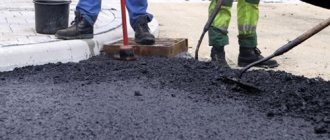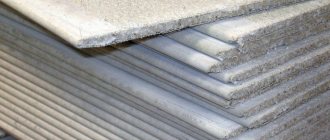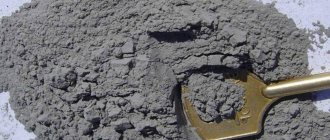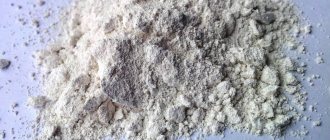Cement M400. Photo Asia Cement
Cement is one of the main building materials. To solve a wide range of problems arising in various fields of activity, manufacturers offer a large number of types of cement. Different types have different compositions and, accordingly, characteristics .
Strength. Activity. Brand.
The main property characterizing the quality of any cement is its strength (grade). The grade of cement is determined by testing standard samples - sticks measuring 4*4*16 cm, prepared from a solution of cement and standard Volsky sand, followed by hardening for 28 days in humid conditions. Tests are carried out in bending and compression. The compressive strength of control samples, expressed in kgf/cm2, is the grade of cement. Cement grades 400, 500, 600 are used in construction. The actual strength of cement is called its activity. Those. if control samples showed a compressive strength of 44 MPa, then the activity of this cement will be 44 MPa (? 440 kgf/cm2), and the grade will be 400. When designing the composition of concrete, it is better to use the activity of cement, as this provides more accurate results and cement savings. In addition to strength, cements are subject to other requirements, the most important of which are normal density and setting time.
Main characteristics of the material
The performance characteristics of heat-resistant cement mixtures are as follows:
- Possibility of operation under constant temperature influence up to +3500°C. Resistant to direct fire.
- Improved fire-resistant properties and strength due to special production technology.
- Increased surface bonding coefficient and optimal viscosity.
- High hardening speed. Structures connected by heat-resistant components can be used within 20 hours.
- No difficulties in preparing the mixture yourself.
- Standard proportions for manufacturing. To prepare a high-quality mixture, it is enough to use a generally accepted recipe, as in the production of traditional brands of cement.
Physico-mechanical properties of cement.
Normal density is the water content (in %) that must be added to cement to obtain a certain consistency of cement paste. Typically this value is 22-27% and increases when finely ground additives that have a high water requirement (tripoli, opoka, etc.) are added to the cement during grinding. Normal density to a certain extent determines the rheological properties of the cement paste and thereby affects the mobility of the concrete mixture. The lower the normal density of cement, the lower the water requirement of the concrete mixture required to achieve a certain mobility (rigidity) of the mixture. Reducing water consumption, in turn, leads to a decrease in cement consumption (at a given W/C). In concrete, it is advisable to use cements with reduced normal density.
The setting time of cement, determined on a special device by the depth of penetration of the needle into the cement paste, characterizes the beginning and end of the process of transforming the material into a solid. According to the standard, it is required that the beginning of setting at a temperature of 20C occurs no earlier than after 45 minutes, and the end is completed no later than 10 hours from the moment the cement is mixed with water. In practice, the beginning of setting occurs after 1-2 hours, and the end - after 5-8 hours. These periods ensure the production of concrete work, because make it possible to transport and lay concrete mixtures and solutions before they set. The setting time can be adjusted by adding various chemical additives to the concrete mixture during its preparation.
Portland cement, as a rule, is finely ground: at least 85% of the total mass of cement must pass through the N008 sieve (about 4900 holes per 1 sq. cm. with a clear cell size of 0.08 * 0.08 mm). The average particle size of cement is 15-20 microns.
The true density of Portland cement without additives is 3.05-3.15 g/cm3. When calculating the composition of concrete, the density of Portland cement in the compacted state is conventionally assumed to be 1.3 kg/m3.
Setting and hardening of cement are exothermic processes. Almost 1 kg of M400 cement releases at least 210 kJ in concrete within 7 days from the moment of mixing the cement with water. For M500 cement this figure is about 250 kJ. Heat generation depends on the mineralogical composition of the cement clinker, the type of additives introduced and the fineness of grinding. Of the clinker minerals, tri-calcium aluminate and tri-calcium silicate have the greatest heat release. The main heat is released during the first 3-7 days of cement hardening.
Cement is transported and stored in such a way as to protect it from moisture, spraying and other losses. Ordinary cement under normal storage conditions after 3 months. loses 20% strength after 6 months. – 30%, after a year – 40%. When using stale cement in the production, the mixing time of the concrete mixture is increased by 2-4 times, hardening accelerator additives are introduced or cement activation is used.
Classification of concrete
Concrete is a mixture formed by mixing cement, crushed stone, water and additives. It differs from cement-sand mortar in the inclusion of filler and purpose.
Depending on the type of binder, concrete is divided into:
- cement; the most common type;
- plaster; characterized by high hardening speed and low volumetric mass;
- silicate; produced on the basis of lime and siliceous components; similar in parameters to cement, used in the production of reinforced concrete products;
- polymeric; based on polyester resins; good material for finishing work - suitable for use on horizontal and vertical surfaces.
Concrete can be ordinary or specialized. The first is used in civil and industrial construction. The second is used for the construction of structurally complex and specific objects.
Types of cement.
The basis of most cements is Portland cement clinker. By normalizing its mineralogical composition and introducing mineral or organic additives, various cements are obtained, slightly different in properties and used in different areas of construction.
• Without additive Portland cement (PC) is a cement that does not contain mineral additives other than gypsum.
Designation according to GOST 10178-85 - PC-500-D0, where
PC – Portland cement.
500 – grade of cement.
D0 – 0% additives (no additives).
• Portland cement with mineral additives. Contains up to 20% granulated blast furnace slag, up to 10% natural active mineral additives (tripoli, opoka, etc.), up to 15% other active mineral additives.
Designations according to GOST 10178-85 - PC-500-D5 or PC-400-D20, where D5 (D20) is the maximum content of additives in cement.
• Portland slag cement. Contains from 20 to 80% granulated blast furnace slag. It differs from PC in slower setting (beginning 4-6 hours, end 10-12 hours) and hardening in the first 7-10 days. During heat-humidity treatment (HMT), the hardening of slag Portland cement is accelerated to a greater extent than that of conventional PC, which makes it highly efficient in the production of precast reinforced concrete.
Designation according to GOST 10178-85 - ШПЦ -400
• Fast-hardening Portland cement. A type of PC with additives. After 3 days of hardening, the compressive strength of this cement is at least 25 MPa, grade 400, 500. Requirements for mineralogical composition: C3S>50%, (C3S+C3A)>60%. Grinding fineness (specific surface area not less than 3500 cm2/g).
• Sulfate-resistant Portland cement and slag Portland cement are produced by normalizing the mineralogical composition, which limits the content of minerals less resistant to sulfate aggression. This cement contains up to 50% C3S, 5% C3A, 10..22% (C3A+C4AF). To obtain sulfate-resistant Portland cement with an additive during grinding, up to 20% of granulated blast furnace slag is added to the cement. The additive binds calcium oxide hydrate released during C3A hydration, which helps to increase the sulfate resistance of cement; in this case, the C3A content is limited to 8%. Sulfate-resistant cements are intended for concrete and reinforced concrete structures operating in conditions of variable water levels, as well as structures that are exposed to the aggressive effects of sulfate water with simultaneous repeated freezing and thawing or repeated wetting and drying.
The manufacturer guarantees that the cement meets the requirements of GOST at the time of receipt of the cement, but no more than a month after shipment. In the passport, in addition to the type and brand of cement
and the name of the manufacturer, the normal thickness of the cement paste and the average activity of cement when steamed according to the regime of 2+3+6+4 hours, at an isothermal heating temperature of 85°C and tested one day after production are indicated.
Production
The raw materials for the production of Portland cement are natural minerals, such as:
- limestone,
- chalk,
- marl,
- slate,
- clay minerals.
Raw materials are obtained in quarries, located, as a rule, next to the cement plant. Next, the extracted material is transported, crushed in crushing units and entered into high-temperature annealing furnaces. The result is cement clinker - a product in the form of granules, obtained by firing at sintering temperatures of 1700 degrees and above.
At the final stage, the clinker is thoroughly crushed into powder, which is the final product – cement.
Cement is a hygroscopic substance and, if stored for a long time or improperly, is capable of absorbing water vapor from the air, completely losing its astringent properties.
Special types of cement.
• White Portland cement is produced by grinding low-iron bleached clinker, prepared using a special technology that prevents its contamination, with the required amount of gypsum and a small addition of diatomaceous earth. According to the degree of whiteness, white cement is divided into three grades: highest, BC-1, BC-2. Brightness coefficients are 80, 76, 72%, respectively. The brightness coefficient of barium sulfate is taken as 100%.
• Colored Portland cements are produced by grinding together white clinker, gypsum and pigment. The content of mineral synthetic or natural pigment should not exceed 15%, and organic pigment - 0.3% by weight of cement. White and colored cements are intended for producing colored concrete, architectural details, facing slabs, and finishing work.
• Tensing cement is produced by co-grinding Portland cement clinker and a tensing component, which includes aluminous slag or other aluminum-containing substances, gypsum and lime. It has the ability to expand significantly in volume (up to 4%) after the cement stone reaches a relatively high strength of 15-20 MPa, which makes it possible to use this cement for the production of self-stressed reinforced concrete, in which the reinforcement receives prestress due to the expansion of concrete. Tensile cement and concrete based on it have high strength, water and gas impermeability.
It is advisable to use it for the manufacture of self-stressed reinforced concrete pipes, road and airfield pavements, tunnels and other similar structures. It should be taken into account
rapid setting of such cement (start 2 minutes, end 6 minutes), as well as the need to use special hardening modes that ensure expansion of the cement only after the concrete reaches the strength necessary for anchoring the reinforcement.
• Expanding or non-shrinking cements are used to prepare waterproof concrete. A special feature of these cements is the presence of components that increase in volume as a result of physical and chemical processes occurring during cement hardening.
• Acid-resistant cement is used for the production of acid-resistant or heat-resistant concrete.
This cement consists of thoroughly mixed ground quartz sand and sodium fluoride, it is mixed with liquid glass (Na2O(K2O)*nSiO2). To obtain the required consistency, liquid glass is diluted with water.
Directions for use
Heat-resistant cement can be used for a wide variety of works in the construction industry. However, due to its high cost, it is usually used for the construction of buildings and structures exposed to high temperatures. This solution is especially in demand for industrial premises and private homes.
The list of main areas of use is as follows:
- Organization of monolithic lining during repair and restoration work with thermal and melting equipment, which is operated at temperatures up to +1600°C.
- Construction of reinforced concrete structures resistant to high heat.
- Production of blocks and bricks with fire-resistant characteristics.
- Production of mortar for brickwork and coating of sauna stoves.
- Creation of adhesive bases for the oil refining industry.
- Construction of furnaces for glass production.
- Construction of fireplaces and stoves for residential properties.
- Installation of smoke exhaust systems.
Heat-resistant mixtures are also necessary for mining or metallurgical activities. They are also indispensable for arranging tunnels, substrates and other structures subject to intense heating.
Primary colors of granite. What determines the color of granite?
Minerals that make up rocks can have different colors. This is explained by the mineral composition of which the rock is made. So if Si, Al, K, Na are present in the rock, then they will be colored in light colors (quartz, muscovite, feldspars). And if Fe and MgCa are present in the rock, then they will have a dark color (magnetite, biotite, amphiboles, pyroxenes, olivines).
Color range of minerals
What rocks form granite?
Granite is a material that was formed from igneous rocks. Igneous rocks are formed when cooling magma hardens both underground (intrusive) and on its surface (effusive). Based on the alkali content, igneous rocks are divided into rocks of the normal series (that is, the ratio of the sum of alkalis to the alumina content is 1). According to the silica content, SiO2 can be acidic (silica from 67 to 75%), moderately acidic (from 67 to 52%), basic (from 40 to 52%) and ultrabasic (
What is granite made of?
Granite is a material that is used in the construction industry. But in order to use it, it must be processed and given certain sizes and shapes. After processing, this product is called crushed stone. Crushed stone can have different sizes, starting from 1 mm and ending with 120 mm (rubble stone). Crushed stone can also be classified according to shape, that is, according to the content of cuboid-shaped grains. The cuboid shape of crushed stone directly characterizes the level of adhesion to the binder components in the solution. The higher the cubicity index, the lower the consumption of crushed stone and other materials, since it is more compact, which means there will be slight shrinkage, and therefore the structure will have increased rigidity. One of the types of products obtained is granite screenings or gruss. Its particle sizes range from 0 to 5 mm. Used for filling and laying paving slabs.
Crushed stone is used in the manufacture of foundations as the main material, which is a filler in solutions. Used for septic tanks and drainage. Crushed stone is used in the manufacture of reinforced concrete slabs and in the construction of drainage systems. Crushed stone is used by road construction companies to prevent the road surface from sagging due to the weight of trucks. Or where asphalt is expensive to lay and they are simply used to fill roads and nearby areas. Read our new article about concrete. Go back to the main page.
vote
Article rating
What is Portland cement and Portland slag cement, what are they used for?
What is Portland cement, and how does it differ from Portland slag cement?
Portland cement is a hydraulic binder that hardens in water and air, obtained by co-finely grinding clinker and the required amount of gypsum added to regulate setting times. Portland cement is used for laying foundations and preparing plaster mortars.
To obtain Portland cement, such technological operations as the production of raw materials; converting it by firing before sintering into clinker and grinding the latter into a fine powder are the main ones.
The chemical composition of Portland cement clinker is determined by the content of the most important oxides, which must be within the following limits.
Natural marls, as well as mixtures of limestone and clay in a ratio of 3:1 (by weight), meet this condition. You can replace limestone with chalk.
Tricalcium silicate (alite) is chemically active in reaction with water. It is able to harden quickly, while having high strength.
Dicalcium silicate (belite) is less active, hardens more slowly, and the hardening product has low strength.
Tricalcium aluminate is a chemically active mineral. It hardens quickly, but the hardening product has low strength.
Tetracalcium aluminoferrite occupies an intermediate position in terms of activity in reaction with water, hardening speed and strength between tricalcium and dicalcium silicates.
The process of interaction of cement powder with water is accompanied by the release of heat. The amount of heat depends on the rate of hydration and the mineralogical composition of the cement. The fineness of grinding, timing and storage conditions have less influence on this indicator.
Samples made from Portland cement should uniformly change volume when boiled in water, therefore the amount of sulfuric anhydride SO3 in Portland cement and its varieties should be no less than 1.5 and no more than 3.5%, and the content of magnesium oxide MgO in the original clinker should not be more than 5%. Portland cement with mineral additives can contain up to 20% of granulated slag, or up to 10% of active additives of sedimentary origin (except glièges), or up to 15% of other active additives, including glièges.
What is Portland slag cement and where is it used? This hydraulic binder is made by grinding together Portland cement clinker, granulated blast furnace slag (21-60%) and the required amount of gypsum. Rapid-hardening Portland slag cement is the main type of this cement. The main difference between Portland slag cement and Portland cement is the slower rate of setting and hardening. It is used in the same place as Portland cement.
Chemical and mineralogical composition of clinker and Portland cement
Definition and classification. Portland cement is a hydraulic binder obtained by finely grinding Portland cement clinker with the addition of gypsum.
Gypsum dihydrate in an amount of 1.5 ... 3.5% is introduced to regulate the setting time of Portland cement. Portland cement clinker is a product of firing before sintering of a raw material finely dispersed homogeneous mixture consisting mainly of limestone and clay. This composition of the raw material ensures the predominance of highly basic calcium silicates in the clinker. 1) Additive-free - the introduction of active mineral additives is not allowed; it is obtained by grinding only Portland cement clinker with the addition of gypsum. Non-additive Portland cement is abbreviated as D0.
2) Portland cement with active mineral additives. This is the name for binders obtained by joint grinding of Portland cement clinker and an active mineral additive, or by mixing them after separate grinding. Rocks (diatomaceous earth, tripolite, opoka, volcanic ash, pumice, etc.) and solid or dusty industrial waste (blast furnace slag, nepheline sludge, thermal power plant fly ash), consisting mainly of amorphous silica, are used as such additives.
3) Slag Portland cement (SPC). This variety includes a hydraulic binder, which is obtained by jointly grinding Portland cement clinker and granulated blast furnace slag with the addition of gypsum. Portland slag cement can also be produced by mixing these components after they have been separately crushed. The slag content in such a binder ranges from 20 to 80% by weight of cement.
4) Pozzolanic Portland cement (PPC). This hydraulic binder is obtained by grinding together Portland cement clinker, gypsum and active mineral additives in an amount of 21...30% or by thoroughly mixing the same components, crushed separately. Taking into account the increased amount of active mineral additive, Portland cement clinker is required to contain tricalcium aluminate - no more than 8%.
Raw materials. The main raw materials in the production of Portland cement clinker are limestone with a high content of calcium carbonate (chalk, dense limestone...) and clay rocks containing SiO2, Al2O3, Fe2O3
The production of Portland cement consists of the following processes: extraction of raw materials and their delivery to the plant; preparation of raw materials and mixtures; burning the mixture to produce clinker; grinding clinker with additives to produce cement.
Mineralogical composition. The raw materials used for the production of Portland cement clinker ensure that highly basic calcium silicates predominate in it. In addition, when interacting with the oxides Al2O3 and Fe2O3, separate groups of minerals are formed. Each of the clinker minerals has its own specific properties.
Tricalcium silicate (alite) is characterized by the chemical formula 3CaO·SiO2 (abbreviation C3S). Its content in Portland cement is 40...65%. Being a chemically active mineral, it has a decisive influence on the rate of hardening of cement. Alite quickly gains strength, forming a fairly dense hydration product. When interacting with water, it releases a large amount of heat.
Dicalcium silicate (belite) has the chemical formula 2CaO·SiO2 (abbreviated as C2S). In terms of chemical activity it is noticeably inferior to alite. The hardening product of belite mixed with water in the early stages of hardening has low strength, and very little heat is generated. However, in the future, under favorable conditions, it is able to increase strength over several years. Belite in Portland cement can contain from 15 to 40%.
Tricalcium aluminate as a chemical compound is expressed by the formula 3CaO·Al2O3(C3A). It has the highest chemical activity among the main minerals of Portland cement clinker. The process of its hydration is completed in the first day of hardening, during which the greatest amount of heat is released. However, the hardening product of tricalcium aluminate has low durability. The content of C3A in Portland cement ranges from 2 to 15%.
Tetracalcium aluminoferrite (celite) is accepted as a clinker mineral as the average value of calcium aluminoferrites of variable composition contained in Portland cement clinker. The chemical composition is expressed by the formula 4CaO·Al2O3·Fe2O3(С4АF). In terms of chemical activity, it occupies an intermediate position between C3A and alite. The hydration product has a strength lower than that of alite. In Portland cement, C4AF can be from 10 to 20%.
Depending on the mineralogical composition, the following types of Portland cement are distinguished:
– alitic: the C3S content is more than 60%, and the C3S:C2S ratio is more than 4; – belite: the C2S content exceeds 38% with the C3S:C2S ratio less than 1; – aluminate, containing C3A more than 15%; – aluminoferritic (celite), in which C4AF contains more than 18%.
The chemical composition of clinker varies within relatively wide limits. The main oxides of cement clinker are calcium oxide CaO, silicon dioxide SiO2, aluminum oxide Al2O3, iron oxide Fe2O3, the total content of which is 95 – 97%. In addition to them, the clinker composition in the form of various compounds in small quantities may include magnesium oxide MgO, sulfuric anhydride SO3, titanium dioxide TiO2, oxides of chromium Cr2O3, manganese Mn2O3, alkalis Na2O and K2O, phosphoric anhydride P2O3, etc. The content of these oxides in clinker varies within the following limits, %:
Sandstone
Sandstone is the most common mineral formation. The variety of rock types allows it to be used as a building material and ornamental stone.
Characteristics of the breed and its composition
Sandstone stone belongs to the group of psammitic rocks, in which the size of clastic grains ranges from 2 to 0.05 mm. The group is represented by loose varieties or sands and cemented ones (sandstones).
Based on the size of clastic grains, rocks are divided into the following types:
- coarse-grained (2-1 mm);
- coarse-grained (1-0.5 mm);
- medium-grained (0.5-0.25 mm);
- fine-grained (0.25-0.1 mm).
Smaller grains form siltstones. In addition to the grain size, each type of sandstone is characterized by the material composition of clastic grains, cement, the shape of clastic particles, the nature of cement and its formation.
To characterize a breed, it is necessary to establish:
- grain sizes;
- mineralogical composition of cement and rock fragments;
- sandstone color.
When classifying rocks by material composition, the nature of the cement is taken into account. The quantitative characteristics are distinguished:
- monomineral formations (main mineral content - 90%);
- bimineral (clastic material consists of two minerals);
- polymineral (clastic material is represented by several minerals);
- a group of polymictic formations (among the clastic grains there are obvious minerals in an amount of 15-20%).











